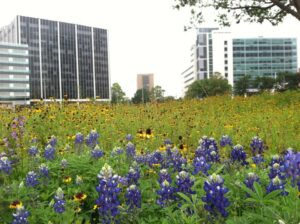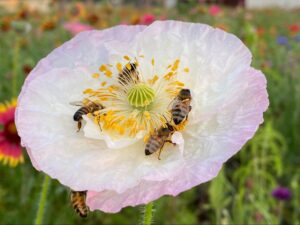Establishing native plants requires you to use high-quality, pure seeds. But before you can put those seeds into the ground, you have to know all about your soil type.
An in-depth knowledge of your soil type allows you to determine the best species for your project, how much water you will need, and what kind of fertilizer you should use.

What Makes Up Soil?
Soil is much more than just the mineral components that many folks think of. In general, a healthy, well-structured soil will be about 5% organic matter, 25% pore space holding air, 25% pore space holding water, and 45% mineral material. Your soil type is determined by these components.
Organic Matter
Organic materials consist of anything that is, or was once, alive and is now in or on the soil. Organic matter, as you would see it identified on a soil test, is organic material that has microorganisms that have decomposed into a stable form that resists further decomposition. Organic matter is essential in soils because it retains nutrients and water, increases water infiltration, and helps soils resist compaction. A good rule of thumb is a 1% increase in organic matter can increase a soil’s water-holding capacity by about 20,000 gallons. Another rule of thumb is that approximately 10-20 pounds of nitrogen can be mineralized for each 1% of organic matter.
Pore Space

Comprising almost 50% of soil, mineral material is a critical component. Apart from gravel and rocks, the mineral material fraction consists of sand, silt, and clay. How these differentiate from each other is particle size. Depending on the percentage by weight of each of these fractions, a particular soil will fall into one of the following texture classes.
Sand
Sand is the largest particle and individual grains can be seen with the naked eye. Its particles can range from 2.0 to 0.05 millimeters in size. The pore spaces between sand grains are usually larger and contribute to good water infiltration. While water will easily enter the soil profile, sandy soils have a low water-holding capacity. Sands also have a low cation exchange capacity, which means they are not chemically reactive and do not strongly hold onto soil nutrients. During high rainfall or irrigation events, valuable nutrients can leach down deep in the profile where shallow-rooted annual plants cannot reach them. One of the benefits of using deep-rooted perennials, like many of our native grasses, is the expansive root systems can access those nutrients from deep in the soil profile.

Silt
Silt is the intermediate size soil particle and requires magnification to see individual particles. Its particles can range from .05 to 0.002 millimeters in size. Pure silt, when dry, has a loose powdery feel akin to talcum powder and does not readily clump together to form aggregates. Silty soils are prone to capping and erosion due to this poor aggregation. Silt is intermediate between sand and clays in respect to cation exchange capacity and nutrient- and water-holding capacity.
Clay
Clay is the smallest size soil particle and requires a microscope to see individual particles. Its particles are less than 0.002 millimeters in size. Although clay has the smallest particles, it has the highest cation exchange capacity and is the most chemically reactive. It also has the most pore space, but those pores are very small. This means clay has the highest water and nutrient-holding capacity. Although clays have a high capacity, the water and nutrients are not necessarily readily plant available since they are tightly bound to the clay.

While knowing the characteristics of the individual components that make up a soil’s texture is important, most soils are a mixture that has the characteristics of all its components. As seen in the following soil map, a single section of the Bamert seed farm has several different soil textures from the triangle, ranging from fine sandy loams to loam to clay. You can easily create a similar soil map and get more information about your property using this online tool https://seedspec.com/. In this section, we grow several different grasses and forbs in addition to production crops in rotation.


The Right Seed for Your Soil Type
At Bamert Seed Company, we raise over 140 species of grasses and forbs for seed production on our farms. While certainly not the only criteria, selecting the species adapted to our soil types is a major consideration when deciding what to grow where.
General species adaptation to soil types.
Common Name | Scientific Name | Sandy Soil | Loamy Soil | Clay Soil |
Blue Grama | Bouteloua gracilis | 2 | 1 | 1 |
Big Bluestem | Andropogon gerardii | 2 | 1 | 1 |
Little Bluestem | Schizachyrium scoparium | 1 | 1 | 1 |
Buffalograss | Buchloe dactyloides | 3 | 1 | 1 |
Galleta | Hilaria jamesii | 1 | 1 | 2 |
Green Sprangletop | Leptochloa dubia | 1 | 1 | 2 |
Illinois Bundleflower | Desmanthus illinoensis | 1 | 1 | 1 |
Indiangrass | Sorghastrum nutans | 1 | 1 | 2 |
Sand Lovegrass | Eragrostis trichodes | 1 | 1 | 3 |
Maximilian Sunflower | Helianthus maximiliana | 1 | 1 | 1 |
Partridge Pea | Chamaecrista fasciculata | 1 | 1 | 1 |
Plains Bristlegrass | Setaria leucopila | 1 | 1 | 1 |
Purple Prairie Clover | Petalosteman purpureum | 2 | 1 | 1 |
Sand Dropseed | Sporobolus cryptandrus | 1 | 2 | 3 |
Sideoats Grama | Bouteloua curtipendula | 2 | 1 | 1 |
Switchgrass | Panicum virgatum | 1 | 1 | 1 |
Western Wheatgrass | Agropyron smithii | 3 | 1 | 1 |
1 = Adapted 2 = Moderately Adapted 3 = Poorly Adapted
While we cannot alter a soil’s texture, the ways we manage soils and the plants growing on them have significant influence on the soil’s porosity and organic matter content, which are big factors in the overall health of the soil. Bamert experts are available to help you determine the right mix of plants and provide guidance on their management so that your soils can reach their potential.

As mentioned above, Seed Spec is an easy-to-use online tool that helps you quickly and efficiently identify the right seed for your soil. Whether you are a government agency, contractor, engineer, or landowner, your project’s success depends on creating a native seed blend adapted to your site. Seed Spec uses cutting-edge technology to seamlessly pull data from multiple sources and quickly develop custom seed blends that help to ensure your project’s success.
Simply draw the boundaries of your project or upload a shape file on top of your map. Seed Spec creates a custom report showing the native species and varieties that fit your area of interest based on your soil types and ecological site data. This tool will save hours per project, helps to eliminate replants, and ensure a high probability of success the first time.
Learn more at https://seedspec.com/




